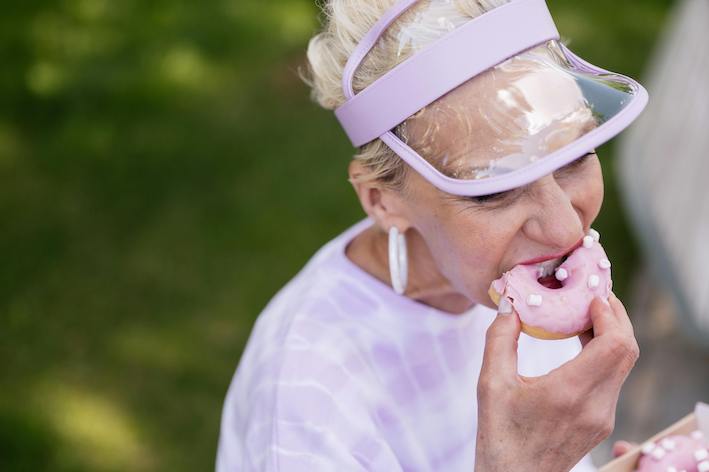Menopause and metabolism: What exactly happens in the body?
Many women find that they gain weight significantly faster during and after menopause, especially in the abdominal area, which they find unpleasant. Even tried-and-tested methods of losing the pounds suddenly work much less effectively. At the same time, it seems as if the body responds more slowly to dietary changes and exercise. But what exactly happens in the body? While these metabolic processes also represent a complex interaction of various influencing factors, we will try to explain the most important factors and their interplay in a simplified manner here—the medical professionals among you may forgive us. The focus is on a fundamental understanding of what women face during menopause and on understanding which strategies help to achieve the most effective health progress.
Your metabolism effectively slows down during menopause and hormonal changes are one of the main causes
During menopause, estrogen levels drop rapidly. Estrogen is a hormone that plays a central role in your fat metabolism. How well fat metabolism works—that is, the production of energy from body fat versus more readily available glucose from your blood—has far-reaching consequences for your metabolism, which we'll take a closer look at here.
1. Estrogen and fat distribution
Estrogen is a key hormone that accompanies the female body throughout life and regulates numerous metabolic processes. One of estrogen's functions is to control where fat is stored in the body. In the years before menopause, women tend to store fat in the hips, thighs, and buttocks—a so-called subcutaneous fat distribution, which is considered healthy and associated with fewer health risks. However, this changes significantly with the onset of menopause.
As estrogen levels drop during menopause, the body shifts its fat deposits. Fat is increasingly stored in the abdominal area (so-called visceral fat) instead of in traditional areas like the hips and thighs. This shift has far-reaching health consequences, as visceral fat is far more problematic than subcutaneous fat (fat directly beneath the skin). However, this can be effectively counteracted with targeted lifestyle adjustments.
- The role of insulin resistance: Why fat burning is blocked
Another important factor influencing fat distribution and metabolism is increasing insulin resistance . Insulin is a hormone that ensures glucose (sugar) is transported from the blood into the cells, where it is used as energy or stored. As long as insulin is circulating in the blood, fat burning is blocked , as the body primarily works to regulate blood sugar levels. This phase lasts longer when insulin levels are elevated—a situation that is exacerbated during menopause due to hormonal changes and reduced insulin sensitivity.
In other words, during menopause, your body responds less efficiently to insulin, a phenomenon known as insulin resistance . This causes insulin levels to remain high for longer, which not only inhibits fat burning but also leads to more fat being stored—primarily in the abdominal area as visceral fat.
3. Why you should counteract visceral fat
While subcutaneous fat (the fat directly beneath the skin) primarily serves as an energy store, visceral fat is much more than that. It is metabolically active , meaning it acts like its own hormone-producing organ.
Visceral fat produces hormones and messenger substances that deeply affect the metabolism and have negative consequences:
-
Production of inflammatory mediators : Visceral fat releases pro-inflammatory substances such as cytokines, which promote systemic inflammation in the body. Chronic inflammation is linked to a variety of diseases, such as cardiovascular disease, type 2 diabetes, and even certain cancers or mental health conditions (depression, anxiety disorders, migraines, Alzheimer's disease, brain fog).
-
Increased insulin resistance: Visceral fat produces hormones that further reduce insulin sensitivity , meaning your body no longer responds to insulin as effectively. This leads to a vicious cycle: The body produces more insulin to regulate blood sugar levels, but this increased insulin level, in turn, blocks fat burning and promotes the storage of even more fat—especially in the abdominal area.
- Release of free fatty acids : Visceral fat also releases increased amounts of free fatty acids into the bloodstream. These fatty acids enter the liver, where they negatively impact metabolism, disrupt fat utilization, and can contribute to the development of fatty liver disease . Fatty liver disease is one of the early precursors to serious metabolic diseases such as type 2 diabetes.
4. How blood sugar tracking can help
Both insulin resistance and visceral fat aren't just a fateful condition we women in menopause simply have to accept. Both symptoms can be significantly reduced if you understand their mechanics and significance (for example, you will, after reading this post). Continuous glucose monitoring (CGM) allows you to track in real time how your body reacts to different meals and lifestyle factors. This allows you to detect changes in your blood sugar levels and adjust your diet and exercise habits accordingly to reduce the storage of visceral fat. When your body goes without carbohydrates for a while, it becomes increasingly easier to access fat reserves, thus melting away the visceral fat. You'll see that the vicious cycle of weight loss during menopause can be broken, albeit with a little perseverance, but essentially with simple means. A CGM-supported program makes sense because you can only reduce insulin resistance if you recognize peaks from supposedly healthy meals, stress, sleep deprivation, and lack of exercise.
Three examples from our menopause program participants show you that this is not always so easy:
 Tine, 50: The "healthy" breakfast cereal. Tine thought she was eating particularly healthy: "I always ate cereal with yogurt and fruit in the morning because I thought it was the perfect healthy choice." But blood sugar tracking showed her that this meal caused her blood sugar to spike rapidly and intensely, only to plummet again shortly afterward. The result: cravings and fatigue by mid-morning.
Tine, 50: The "healthy" breakfast cereal. Tine thought she was eating particularly healthy: "I always ate cereal with yogurt and fruit in the morning because I thought it was the perfect healthy choice." But blood sugar tracking showed her that this meal caused her blood sugar to spike rapidly and intensely, only to plummet again shortly afterward. The result: cravings and fatigue by mid-morning.
What Tine has changed: "Now I eat scrambled eggs with spinach or tomatoes and a thin slice of wholegrain bread for breakfast. This keeps my blood sugar stable and I feel full and energized until lunch."

Anna, 48: The "easily" digestible lunch salad. Anna was convinced that her daily chicken breast salad was the best thing for her figure. But blood sugar tracking showed that while her low-fat salad sounded healthy, it wasn't enough to keep her blood sugar stable. Her body reacted to the lack of fat and protein with afternoon cravings.
What Anna has changed: "I learned to add healthy fats to my salad, like nuts, hummus, and olive oil. Now I feel full after eating and no longer have cravings in the afternoon."
 Claudia, 52: The smoothie for an energy boost Claudia often drank a smoothie as a snack to feel energized in the afternoon. But to her surprise, the CGM showed that the combination of fruit and juice led to extreme blood sugar spikes, followed by a drop in energy. "I thought I was doing something good for my body, but my blood sugar was completely out of control."
Claudia, 52: The smoothie for an energy boost Claudia often drank a smoothie as a snack to feel energized in the afternoon. But to her surprise, the CGM showed that the combination of fruit and juice led to extreme blood sugar spikes, followed by a drop in energy. "I thought I was doing something good for my body, but my blood sugar was completely out of control."
What Claudia has changed: "Now I make smoothies with less fruit but more protein sources like Greek yogurt and chia seeds. My blood sugar stays much more stable, and I feel energized."
5. What you can do about it
All of the described side effects of menopause can be significantly reduced or even eliminated through targeted adjustments to your daily routine. Our Menopause Program will show you in real time where adjustments are most worthwhile, so your efforts will be rewarded. In general, the program addresses the dimensions that have been sufficiently medically proven:
1. 💡Use CGM to understand which meals don't work well for you and destabilize your blood sugar
The first step to weight loss is stabilizing blood sugar levels. Severe fluctuations in blood sugar lead to cravings and slow fat loss. Blood sugar tracking can help determine which foods keep your blood sugar stable and which cause significant fluctuations. A diet rich in protein, healthy fats, and high-fiber carbohydrates supports stable blood sugar levels.
2. 👟Build and maintain muscle mass
Muscle mass is key to keeping your metabolism active. Since muscle mass is lost more rapidly during menopause, it's especially important to incorporate regular exercise into your daily routine to counteract muscle loss. More muscle means higher calorie burn, even at rest.
3. 🥗Adjust your calorie intake
Because the body burns fewer calories during menopause, it may be necessary to reduce calorie intake somewhat to lose weight. It's important to pay attention to the quality of your food—focus on nutrient-dense foods and avoid empty calories like sugar and processed snacks. We recommend this NDR article on visceral fat:
 Source: NDR “Getting rid of belly fat: How diet and exercise can help”
Source: NDR “Getting rid of belly fat: How diet and exercise can help”
4. 🧘Reduce stress
During menopause, the body produces more stress hormones like cortisol, which can inhibit fat loss and lead to weight gain. Stress management is therefore especially important to support metabolism.
5. 😴Optimize sleep
Lack of sleep can also slow metabolism and increase hunger. During menopause, many women struggle with sleep problems, which complicates the weight loss process.
It's in your hands, and we'd be happy to help you shed light on the situation!





